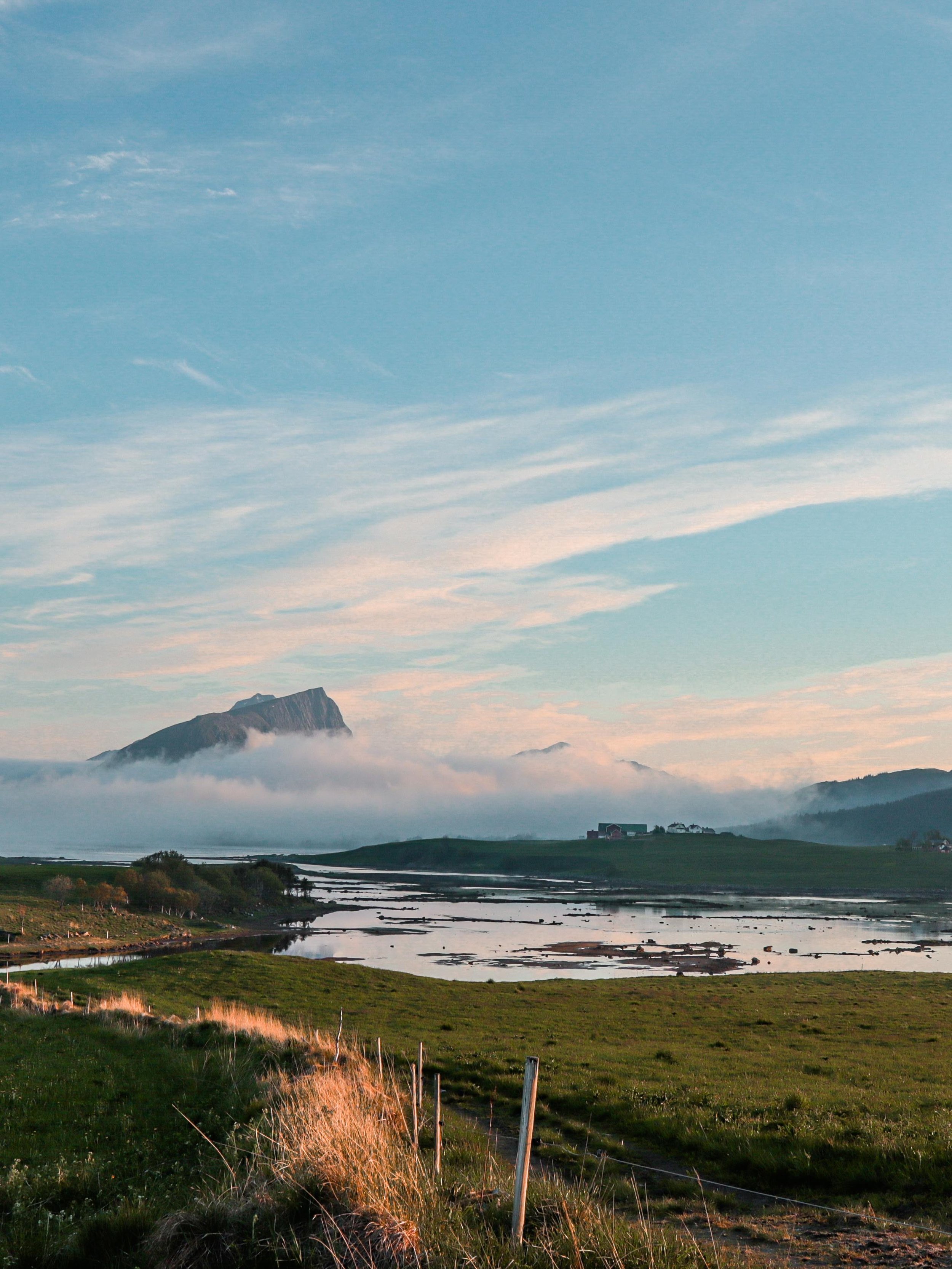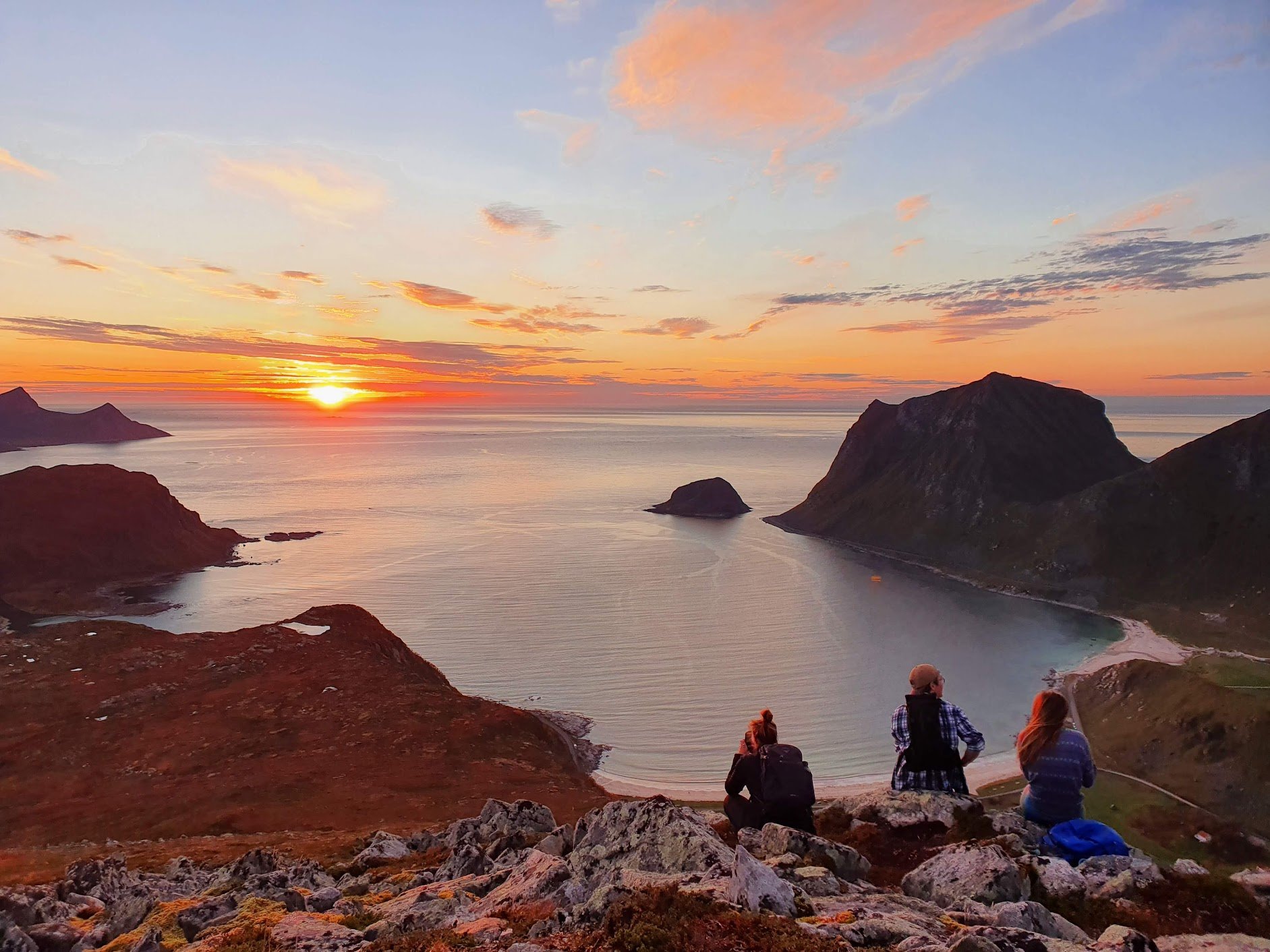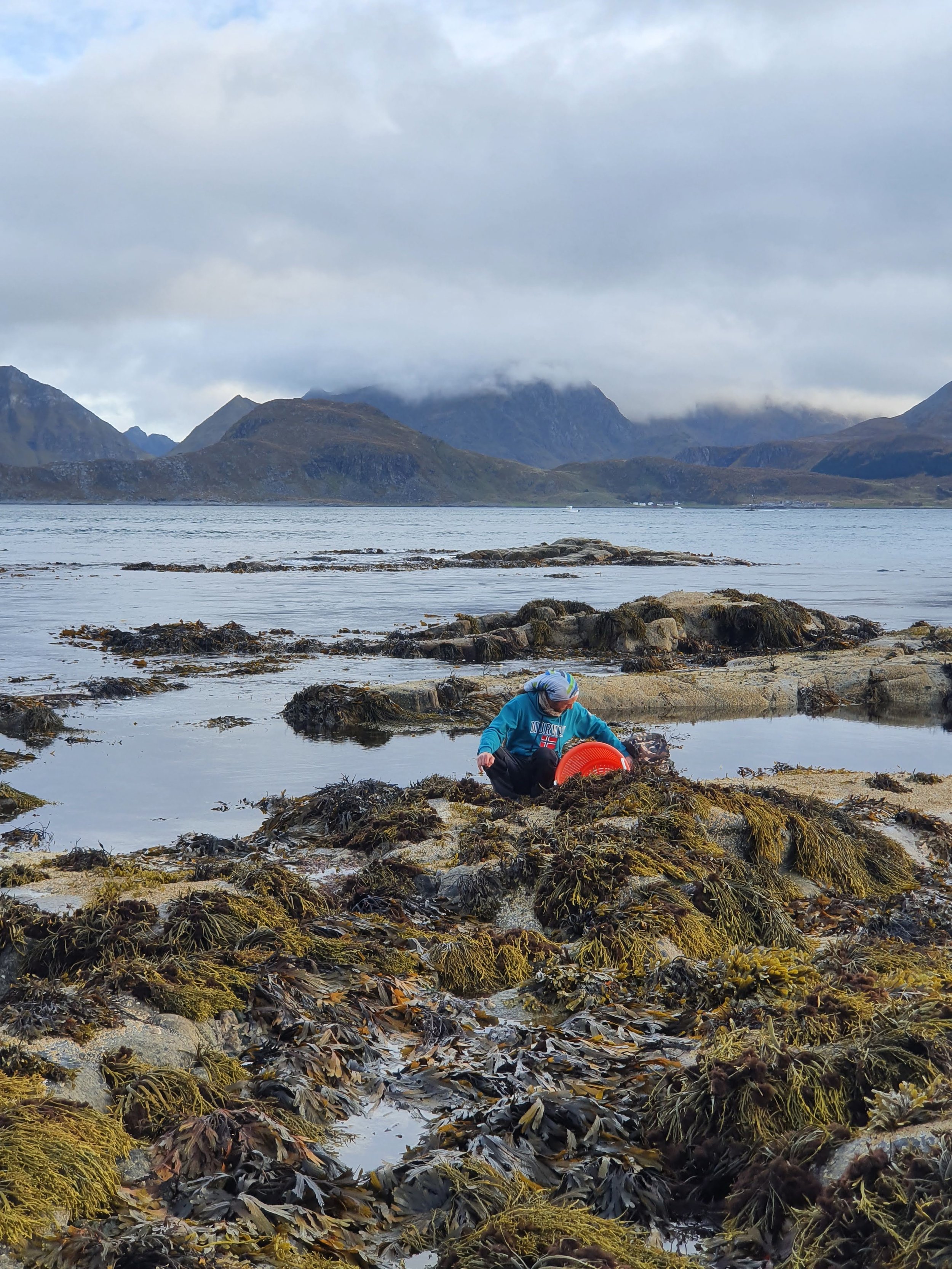Seaweed, mountains and auroras - My 6 months in Lofoten
The Lofoten Islands on the northern Norwegian coast are notorious for their beauty. Sharp mountain peaks rising dramatically from the arctic ocean, red fishing huts, drying racks laden with cod, and sheep peacefully grazing in the midnight sun.
Rorbuer and drying racks for stockfish in Reine, with a view of Olstinden.
What they don’t tell you is this though - Weeks on end of never-ending rains. Storms and gales. Sub 10 degrees in the summer. And that exotic turquoise water? Well, surprise surprise, it’s colder than a witches tit.
But as you’re about to see, living there has its perks. What the islands lack in weather stability and grocery store fruit selection, she more than makes up for.
I came for a summer job and the chance to take some pretty photos. Little did I know I would end up doubling my stay and meet so many inspiring and amazing people.
The Beginning
In May last year I was looking for a sommer job someplace far away from Oslo. A year of lockdowns in the city had me set on going someplace where there would be nature and excitement. I was looking through instagram when I came across Lofoten Seaweed, a seaweed harvesting company run by two women - Tamara and Angelita. The page had multiple pictures of them braving the arctic waters in wetsuits pulling up handfuls of kelp. I was sold.
You can check them out here, and read their story. It’s a cool one, and they explain it way better themselves.
A phone call, an application and a few months later, Tamara came to pick me up at the tiny Leknes airport. When I arrived in early June the sun was shining non stop for 3 days ( those few days when I arrived turned out to be the sunniest of my entire stay), and I felt as though I had landed in a fairytale world.
I was excited for work, but I really didn’t know what to expect. I knew they had hired a chef and another girl that would be doing the same thing as me. And that I would MAYBE get to come harvesting.
Imagine my disappointment when Tamara told me about the end-of-harvest party they had just had the night before I arrived. No mermaid action in a wetsuit picking seaweed for me.
Lofoten is mostly farmlands and wilderness. We lived close to Leknes, the biggest hub on the Vestvågøy Island, and only one of two villages with an official “city” status in Lofoten.
The house was an old white farmhouse at the end of a gravel road, just a 5 minutes drive from Haukland beach. This beach just so happens to be Europes best, should we believe Lonely Planet. And let me say, I’m inclined to agree.
From the top of Holandsmælen with a view of Haukland Beach and Veggen.
Seaweed Gourmet Adventures
While everyone else was out surfing and enjoying the sun - we were bustling around the Seaweed headquarters creating a pop-up restaurant. “Tangeriet” quickly became a hotspot for foodies and tourists wanting to try a different kind of food experience. But not without a decent amount of work on our part, as I'm sure anyone who’s ever dipped a toe into restaurant business would be keen to tell you.
I once saw our chef Jacek pull a 24 hr stint in the kitchen to prep a 7 course meal solo only to go home, sleep 4 hours, and then do the evening service. You don’t forget that shit. That dedication carried over in his food, and oh my, I have never eaten as well as I did working there.
Helping set up a restaurant was as exciting as it was stressful. My biggest take-away was that the road from idea to finished product/event is often way shorter, and way more chaotic, than what you might first think.
This text would not be complete without mentioning the great variety in local food that Lofoten offers. I was genuinely surprised, but I suppose that says more about me than Lofoten. We’ve crossed the arctic circle after all, and what could possibly grow here? Turns out - a lot of stuff.
I’ve never foraged and eaten as much locally produced food as I did in Lofoten. Berries in all shapes and colors, fresh fish, mussels, urchins, herbs, pine shoots, fruits, plenty of mushrooms and seaweed. But you need to know where to find it. Either by having contacts with farms and fishermen directly, or do it the old way and just get it yourself.
My favourite project of the summer was the mural I did for the restaurant facade. A 10 m long winged kelp leaf in the signature teal of Lofoten Seaweed. I started out with a couple of sketches on paper, ordered the paints and supplies, then went to work. I sketched the leaf with a blue spray can first, then started blocking in colors with acrylic paint.
Winged kelp grows in abundance along the shores of lofoten, and plays a vital part in the tidal ecosystem. Photo by Kent Roar Nybø for Lofot Tidende.
Harvest Season
As autumn rolled around, the colors of the landscape changed from bright green to rusty golds and oranges. The weather grew more unpredictable, and wind warnings became an everyday feature. It was time to harvest truffle seaweed.
Germaine harvesting truffle seaweed (vertebrata lanosa). The taste and smell is reminiscent of white truffle.
After a summer of waitressing and working in the office, finally we would be out on the frontlines, out in the tidal zone scanning for tasty algae. There are two harvest seasons a year - one in the spring which I just missed, and a smaller one in the autumn just for truffle seaweed and dulse.
For the first time in my life I was aware of a different kind of clock, and had to plan around a schedule set by the ocean. You see, we could only go out when it was low tide, in order to access those hairy tufts of truffle-flavoured seaweed.
Lofoten is notorious for its surf waves, created by the ocean currents and big differences in the tides. The ocean to pushed and squeezes through the narrow canals between them creating strong tidal currents. Nappstraumen, where we were harvesting all of our seaweed, has the worlds 4th strongest tidal current! There’s an almost 4 meter difference between the highs and lows here.
This is really good for algae growth! The tidal currents bring plenty of fresh nutrients from the ocean floor up to the surface, which helps the seaweed grow faster.
And so the days went by, we would go out for a couple of hours to harvest if the weather and the tide was good, and the rest of the day we would work in the office or go for hikes.
Fellow harvester Caroline and I out in our wetsuits picking dulse seaweed.
Winter Darkness
As autumn turned to winter, the days became drastically shorter. It was too dark to harvest now. The island had become a snow-covered, grey-blue wasteland where auroras appeared dancing in the sky.
We would see shimmering lights in the sky when the weather was clear. Most times it was very faint, and honestly not that impressive. The first few times I saw the auroras I didn’t get what the fuss was about until finally, one night, great bands of light were snaking and coiling over the sky. Green, white and pink lit up the sky like flames. You really can see it moving, it is as if the light is alive and has a mind of its own.
It was an enchanting sight, and I couldn’t help but think about all those people who for thousands of years were looking to the skies, seeing spirits and gods reveal themselves.
In the office we had reopened the restaurant for christmas parties, but it didn’t take long before new covid restrictions put a damper on the operation.
Northern lights over Uttakleiv.
Days and weeks went by, until finally it was time for me to leave. I must admit that by this point I was ready to head down south, back to sunlit civilisation. Besides, I was excited to spend christmas with my family. I was happy to have completed a lot of the goals I had set out for myself - learning more about photography, content production, finishing my exams and starting my drivers license. But I also felt I was leaving some experiences on the table still, there were still so many things I wish I’d seen or done. All the more reason to come back at another time.
All in all the people I met up north taught me a lot, and I was sad to leave them. I’m glad I took a chance with something as obscure as seaweed. I know I can always return to this place that has now become like a second home.






